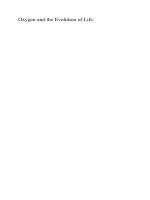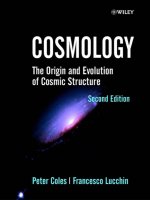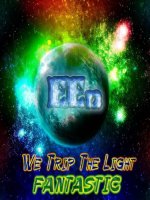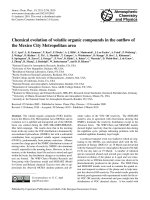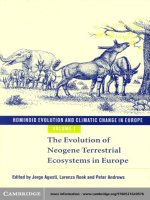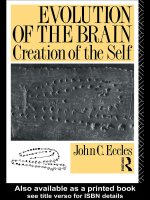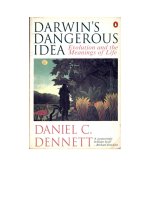Bookflare net the evolution of molecular biology the search for the secrets of life
Bạn đang xem bản rút gọn của tài liệu. Xem và tải ngay bản đầy đủ của tài liệu tại đây (22.35 MB, 303 trang )
The Evolution of Molecular Biology
The Search for the Secrets of Life
FIRST EDITION
Kensal E. van Holde
Oregon State University, Department of Biochemistry and Biophysics, Corvallis, OR, USA
Jordanka Zlatanova
University of Wyoming, Department of Molecular Biology, Laramie, WY, USA
Table of Contents
Cover image
Title page
Copyright
Preface
Chapter 1: Beginnings
Abstract
Prologue
Some Ancient Intuitions
Spontaneous Generation
Vitalism
The Demise of Vitalism
The Rise of Modern Biology
The Microscope Opens a New World
Epilogue
Chapter 2: The Origins of Biochemistry
Abstract
Prologue
Recognition of Proteins
Some Proteins Are Catalysts: Enzymes
What Enzymes Do, and Why It Is so Important
How Do Enzymes Work?
Proteins Fulfill Many Roles
What Are Proteins Made of?
Epilogue
Chapter 3: The Chemical Structure of Proteins
Abstract
Prologue
The Peptide Hypothesis
Colloid or Macromolecule?
Some Unexpected Results
Proteins as Homogeneous Polypeptides
Fred Sanger and the Sequence of Insulin
Epilogue
Chapter 4: Proteins in Three Dimensions
Abstract
Prologue
Fibers
Globules
The First Globular Protein Structures
Epilogue
Chapter 5: The Origins of Genetics
Abstract
Prologue
Classical Genetics and the Rules of Trait Inheritance
Friar Gregor Mendel Plants Some Peas
Mendel Formulates the two Laws of Inheritance
Mendel's Laws have Extensions and Exceptions
Mendel Was Long Ignored
Darwin, Mendelism, and Mutations
Genes Are Arranged Linearly on Chromosomes and Can be Mapped
What Do Genes Do, and What Are They Made of?
Epilogue
Chapter 6: Nucleic Acids
Abstract
Prologue
Miescher's Mysteries
The Chemical Structures of Nucleic Acids
“What is Life?”
DNA Carries Genetic Information
Mysterious Numbers
Epilogue
Chapter 7: The Great Synthesis
Abstract
Prologue
Do Bacteria and Bacteriophage Have Genetics?
The Watson-Crick Model of DNA Structure Provided the Final Key to Molecular Genetics
Epilogue
Chapter 8: How DNA is Replicated
Abstract
Prologue
What Is the Mode of Replication?
How Does Replication Proceed?
The Lagging-Strand Problem
Epilogue
Chapter 9: The Central Dogma
Abstract
Prologue
Speaking in Different Languages
Intuiting a Dogma
Who Is the Messenger?
The Great Decade: 1952–62
Epilogue
Chapter 10: The Genetic Code
Abstract
Prologue
How Might a Code Function?
What Kind of Code?
What Were the Code Words?
The Code
Epilogue
Chapter 11: Gene to Protein: The Whole Path
Abstract
Prologue
What Was Known in 1960?
Breakthrough
The Rest of the Story
Regulation of Transcription in Bacteria
Overview
Epilogue
Chapter 12: Eukaryotes Pose New Problems
Abstract
Prologue
What Is a Eukaryote?
The Origins of Eukaryotes
The Three Domains of Life
Interrupted Messages and Splicing
Every Cell Type Has Special Needs and Functions
Multiple Levels of Control
Chromatin and Nucleosomes
Too Much DNA? Junk DNA?
Epilogue
Chapter 13: Development and Differentiation
Abstract
Prologue
Two Ideas About Development Dominated Thinking in Ancient Times
The Introduction of Scientific Approaches to the Field of Development
An Opportunity Missed?
What Do We Know About Development and Differentiation at Present?
ESC Serve as a Model for Pluripotency
The Molecular Basis of Differentiation and Development
Insights From a Simple Worm
Nuclear Transfer Experiments and the Principle of Genetic Equivalence
Genome Reprogramming Toward Earlier Phases of Development is Possible
Epilogue
Chapter 14: Recombinant DNA: The Next Revolution
Abstract
Prologue
The Power of DNA Recombination
How to Clone DNA
Construction of Recombinant DNA Molecules Needs Restriction Endonucleases and Ligases
The First Recombinant DNA Molecules
Polymerase Chain Reaction and Site-Directed Mutagenesis
Manipulating the Genetic Content of Eukaryotic Organisms
CRISPR, the Gene-Editing Technology of Today and Tomorrow
Epilogue
Chapter 15: Understanding Whole Genomes: Creating New Paradigms
Abstract
Prologue
The Evolution of Sequencing Methodology
Genomic Libraries Contain the Entire Genome of an Organism as a Collection of Recombinant DNA Molecules
There are Two Classic Approaches for Sequencing Large Genomes
Ultrafast Sequencing Allows Deep Analysis of Genomes
Whole Genomes
The Human Genome Project
ENCODE Results Raise Question. Whence biology?
So, What Was Learned From ENCODE?
TFs Interact in a Huge Network
Where Is ENCODE Leading?
Attempts at a Contemporary Definition of a Gene
Epilogue
Chapter 16: Whole Genomes and Evolution
Abstract
Prologue
Evolutionary Theory: From Darwin to the Present Day
Classifying Organisms: Phylogenetics
Phylogenetics Goes Molecular
The Comparative Genomics Revolution
Tracing Human Evolution
Epilogue
Chapter 17: Practical Applications of Recombinant DNA Technologies
Abstract
Prologue
Catching Criminals and Freeing the Innocent
Production of Pharmaceutical Compounds in Recombinant Bacteria or Yeast
Genetic Engineering of Plants
Gene Therapy
A CRISPR Revolution?
Cloning of Whole Animals
Jurassic Park or Deextinction
Epilogue
Glossary
Appendix: Nobel Prize Laureates That Have Contributed to the Development of
Molecular Biology
Index
Copyright
Academic Press is an imprint of Elsevier
125 London Wall, London EC2Y 5AS, United Kingdom
525 B Street, Suite 1800, San Diego, CA 92101-4495, United States
50 Hampshire Street, 5th Floor, Cambridge, MA 02139, United States
The Boulevard, Langford Lane, Kidlington, Oxford OX5 1GB, United Kingdom
© 2018 Elsevier Inc. All rights reserved.
No part of this publication may be reproduced or transmitted in any form or by any
means, electronic or mechanical, including photocopying, recording, or any information
storage and retrieval system, without permission in writing from the publisher. Details
on how to seek permission, further information about the Publisher’s permissions
policies and our arrangements with organizations such as the Copyright Clearance
Center and the Copyright Licensing Agency, can be found at our website:
www.elsevier.com/permissions.
This book and the individual contributions contained in it are protected under copyright
by the Publisher (other than as may be noted herein).
Notices
Knowledge and best practice in this field are constantly changing. As new research and
experience broaden our understanding, changes in research methods, professional
practices, or medical treatment may become necessary.
Practitioners and researchers must always rely on their own experience and knowledge
in evaluating and using any information, methods, compounds, or experiments
described herein. In using such information or methods they should be mindful of
their own safety and the safety of others, including parties for whom they have a
professional responsibility.
To the fullest extent of the law, neither the Publisher nor the authors, contributors, or
editors, assume any liability for any injury and/or damage to persons or property as a
matter of products liability, negligence or otherwise, or from any use or operation of
any methods, products, instructions, or ideas contained in the material herein.
Library of Congress Cataloging-in-Publication Data
A catalog record for this book is available from the Library of Congress
British Library Cataloguing-in-Publication Data
A catalogue record for this book is available from the British Library
ISBN: 978-0-12-812917-3
For information on all Academic Press publications visit our website at
/>
Publisher: Sara Tenney
Acquisition Editor: Kristi Gomez
Editorial Project Manager: Pat Gonzalez
Production Project Manager: Priya Kumaraguruparan
Cover Designer: Christian Bilbow
Typeset by SPi Global, India
Preface
Within the past century, a whole new science has arisen, a new way of understanding
biology and medicine. The applications of this science, which has come to be called
molecular biology, pervade every aspect of our lives today and promise even more in the
future. Molecular biology has arisen from roots in biochemistry and genetics—has in fact
fused these disciplines to provide an understanding of life at a much deeper level than
was hitherto possible (Fig. 1.1). A s is often the case with new science, unexpected
applications have arisen and created whole new industries.
I n this book, we will depict the rise and flowering of molecular biology. We will not
a empt an exhaustive history of the field, nor of those scientists who built it. I nstead, we
shall concentrate on the development and flow of ideas. We would like to demonstrate
the complexity of science, the sudden breakthroughs following decades of confusion, the
frequent blind alleys of misconception that tend to hinder progress. We would like to
show how some ideas are slowly crafted by teams of careful and dedicated workers,
whereas others arise from individual strokes of genius.
Finally, while this is a book about science, we will try to avoid esoteric knowledge and
extensive detail, either about scientific procedures or about the scientists themselves.
N evertheless, there is much about those remarkable men and women who created this
field that demands telling, and we shall include biographical material where appropriate.
C H AP T E R 1
Beginnings
Abstract
In this chapter, we have, very briefly, sketched the antecedents of molecular biology, from ancient times until about
1800 AD. Despite the long preexistence of “atomistic” ideas that might have prompted a mechanistic view of
biology, the heavy hands of theology and classical tradition resisted progress, even through the renaissance. In
particular, the doctrines of vitalism and spontaneous generation inhibited real advances until the 19th century. Their
demise, together with the development of the microscope and rational taxonomy, sets the stage for the flowering of
biochemistry and genetics during the early years of the 20th century. These, when finally connected, provide the
basis for what we call molecular biology.
Keywords
Atoms; Renaissance; Vitalism; Spontaneous generation; Microscope; Taxonomy
Prologue
To this chapter, there is no prologue. I t begins with some of the first a empts to explain
the world in natural terms. Before, superstition, in a thousand forms, reigned supreme.
Some Ancient Intuitions
The basic precept of molecular biology can be stated quite succinctly: all the myriad
forms and processes in living things can be explained in terms of atomic and molecular
structures and their interactions with one another. A lthough that level of understanding
has not yet been accomplished (and possibly never will be in view of the extreme
complexity of life), we have never yet encountered impassible barriers to that quest. I t
has come close to realization only in the past century (Fig. 1.1). I ndeed, the very term
“molecular biology” is new. Therefore, it may seem surprising that the basic idea is more
than two millennia old. The Greek philosopher D emocritus and his colleagues in the 5th
century BC proposed a remarkably simple model for the universe. Everything—tables,
chairs, the sun, the moon, grass, even human brains and bodies—was proposed to be
composed of elementary indivisible particles called atoms. They could not, of course,
imagine atoms as we visualize them today, but they correctly guessed that different
objects and substances were created by differing combinations of atoms (which
combinations we call molecules). This is the core of modern chemistry and biochemistry.
The extrapolation of this idea into biology is the basis for a “molecular biology.” This
new science is changing our basic understanding of living organisms, whether they are
unicellular as bacteria or multicellular as plants and animals. A s a consequence of this
basic knowledge, the world we live in is changing.
FIG. 1.1 A schematic of the history of molecular biology.
A lthough it was at odds with every ancient religion or philosophical school and could
not be tested by any techniques that would exist for the next two thousand years, the
atomic hypothesis retained adherents throughout ancient times. At about the beginning
of the Christian era, the Roman poet and philosopher Lucretius composed a remarkable
exposition and elaboration of these ideas in a long poem “D e rerum natura,” usually
translated as “O n the N ature of Things.” Unfortunately, this work vanished for over a
thousand years, until a copy (Fig. 1.2) was discovered in 1417 by a manuscript hunter in a
monastery in central Germany (probably at Fulda). Long before that, during the
thousand years of dark ages following the fall of Rome, much of ancient learning had
been lost and destroyed, including the original works of D emocritus and his school.
What li le biology the Greeks or Romans had created had degenerated into a chaotic
mixture of unrelated observations and stories of fabulous imaginary beasts and plants.
FIG. 1.2 A page from a copy of the manuscript “De Rerum Naturae” by Lucretius. This is probably
one of a long series of copies, the originals being long lost. (From
/>
I t must not be thought that rediscovery of Lucretius and the atomists led immediately
to a rational science. From the fall of Rome (about 500 A D ) until the renaissance (c.
1500 A D ) the church ruled scholastic thought, and such ideas were strongly suppressed.
When scholars ventured beyond specifically theological ma ers, they relied upon a few
works of philosophers such as Plato and A ristotle that had survived the dark ages and
could be (at least partially) reconciled with Christian theology. The figure who stands
out, at the very end of this period, as comparable to a modern scientist, is Leonardo da
Vinci. Leonardo combined enormous artistic skill with a skeptical, inquiring mind to
describe the anatomy of animals, including humans, with accuracy and attention to detail
that would not be rivaled for hundreds of years (Fig. 1.3). Elegant and accurate as
Leonardo's anatomical studies were they added li le to the understanding of mechanism
and function. Great as he was, Leonardo was not a modern scientist, in the sense that he
did not present hypotheses and test them by experiments. He was a marvelous engineer
and a keen observer of nature. I n this sense, he was the forerunner of the great
naturalists who would dominate biology in the 18th and 19th centuries. Even when the
renaissance opened whole new vistas in astronomy, physics, chemistry, and philosophy,
progress in biology was inhibited by two fundamentally erroneous concepts.
FIG. 1.3 Drawing of human anatomy by Leonardo da Vinci. Such drawings were usually directly
from dissections and are usually annotated by the artist. (From />id=88001).
Spontaneous Generation
The first of these was spontaneous generation, the long-held belief that certain simple
animals (flies, worms, frogs, etc.) could arise spontaneously from mud, dung, ro en
meat, and the like. This was debunked in what was possibly the world's first true
biological experiment. The I talian scientist Francesco Redi had observed, like many, that
maggots and then flies appeared on ro ing meat. But he also noted that flies
approaching meat often dropped tiny objects on the meat: he suspected these were eggs.
S o, in about 1668 he did the following experiment: Redi put ro ing fish in two bo les,
one stoppered and one not. He observed, on repeated trials, that the unstoppered bo le
developed maggots, whereas the other did not. Remarkably, Redi still maintained that
some other kinds of primitive creatures were generated spontaneously. S o did many
other biologists, even until the late 19th century, when Louis Pasteur essentially repeated
Redi's experiment. Old ideas die hard.
I t was, however, another ancient fallacy that most inhibited progress in biology during
the renaissance and beyond. This was the doctrine of vitalism, which held that there was
some fundamental difference between living and nonliving matter.
Vitalism
Physics and astronomy flourished during the renaissance. Why did not biology? O ne
reason, as we shall see, is that there was an enormous amount of careful data collecting
and categorizing that had to be done before the requisite information could be logically
ordered. The world of living creatures is incredibly complicated and diverse. But equally
inhibiting, in the view of modern scientists, was the influence of a philosophical doctrine
termed vitalism which asserts that there is a fundamental difference in the nature of
living versus nonliving ma er. Thus, physics and chemistry could never explain life. The
basic idea is ancient and seems almost intuitive—living things seem very different from
the nonliving. The idea gained power in antiquity from the philosophies of Plato and
A ristotle, with their emphasis on the nonmaterial nature of the “soul.” S ome of the
atomists also believed in the soul, but insisted that it, like everything else, was made
from atoms and must obey the same laws.
I n the 17th century, at the pinnacle of the renaissance, Galileo and N ewton had
revolutionized astronomy and physics. N ewton's mathematical analysis suggested a
wholly physical explanation for how the world works and might have been expected to
spell the end of vitalism. However, the influence of the French philosopher Rene
D escartes had a profound effect. D escartes introduced a dualistic aspect; the body was
material, but inhabited by nonmaterial mind, which could direct its actions. This seemed
to allow free will and thus allayed a problem encountered by strict “mechanists.”
However, it insinuated that there still was something “different” about the behavior of
ma er in living things. D escartes' compromise may account for the persistence of
vitalistic ideas until modern times. I ndeed, it has been championed by such authorities
as Louis Pasteur, who pronounced in 1858 that fermentation of sugars involved reactions
that could only occur in living cells. Curiously, Pasteur derived this conclusion from
experiments that definitely ruled out spontaneous generation. I n retrospect, vitalism has,
in the opinions of many, had a distinctly inhibiting effect on the development of a
mechanistic biology.
The Demise of Vitalism
There are two contenders for the scientific work that definitely turned the tide of
scientific thought against the vitalists. The first cites the work of the German chemist,
Friedrich Wöhler, who in 1828 accomplished the synthesis of urea from ammonium
cyanate. Until then urea, a small molecule containing carbon, oxygen, hydrogen, and
nitrogen, had been obtainable only from the urine or kidneys of animals. A mmonium
cyanate was recognized by the chemists of the time as an “inorganic” compound,
whereas urea was considered “organic.” Wöhler's result questioned the distinction
between these classes, a part of the vitalist creed. A more devastating blow to vitalism
came from the work of Eduard Buchner, who showed in 1897 that in contrast to Pasteur's
claim, an extract from broken and dead yeast cells could support fermentation. A s
biochemistry became a major discipline in the early parts of the 20th century, vitalistic
ideas were abandoned by most scientists. Yet even as late as 1913, the eminent British
biologist J .S . Haldane questioned whether mechanistic models could ever completely
explain life. O ne may wonder why some ideas, even when discredited, die so hard.
Perhaps in this case there is an emotional connection; the thought of a completely
mechanistic world is bleak and cold to many.
The Rise of Modern Biology
A ll sciences, in their development, seem to pass through a stage of collecting,
assembling, and organizing information. Cosmology could not explode until data about
thousands of stars and galaxies were accumulated. Chemistry was largely the chaos of
alchemy until the chemical elements could be recognized and systematized in the
periodic table. Biology, in its formative years, faced a formidable task. There are millions
of kinds of organisms, some clearly related, others of no obvious affinities. O rgans and
body plans may reflect a myriad of life styles.
The biological studies of antiquity did not begin to accomplish such goals. Even at
their best, they were sporadic and noncomprehensive anecdotes. I n many cases, data
about real plants and animals was interspersed with accounts of fantastic creatures,
gathered by rumor or hearsay. When the excited minds of the renaissance began to look
seriously at biology, the appropriate starting point was to make order out of this chaos—
recognizing only what was demonstrably true and placing it in a sensible context.
Leonardo da Vinci was the pioneer, examining the growth and forms of plants and
animals, generally disregarding the “authority” of the classic writers. His work on
anatomy is a marvel in this respect. But the anatomist who probably had the greatest
influence during this period was Vesalius, born in Belgium in 1514. He began studies of
medicine in Paris, but soon, disillusioned by the uncritical scholasticism, began his own
careful studies, including dissections of many animals. I n 1543, at the age of 29, he
published “D e Humani Corporis Fabrica” (The Composition of the Human Body). Thi
massive work, which was accompanied by excellent illustrations, served as a physiology
text for generations. A lthough Vesalius still gave some deference to the classical writers,
he found enough to question in them to earn him public condemnation from scholars
and clerics of the time.
I n terms of taxonomy, the renaissance exhibited only the beginnings, stifled by the still
heavy hand of A ristotle. A partial exception was the work of a S wiss, Conrad von
Gessner, born in 1516. He published a massive “Historia animalium,” which, although
still basically A ristotelian in organization, at least excluded many of the more gross
errors of the ancients. The birth of a modern taxonomy would have to wait two centuries.
I n 1735 the great S wedish taxonomist Carolus Linnaeus published “S ystema N aturae”
which introduced for the first time the binomial system we utilize today—in which each
organism is given a genus name followed by a descriptive species name (e.g., Homo
sapiens). O ver the remainder of the 18th century the process of classification proceeded
apace, providing the basis for a systematic biology. N ote, however, that this biology, as
well as early anatomical studies, was restricted to what the unaided eye could examine.
To go deeper into biological structure, the senses must be aided. By 1700, such aid was at
hand, in a spectacular fashion.
The Microscope Opens a New World
I t is often stated that A nton van Leeuwenhoek invented the microscope. This is not
strictly true—there were prototype instruments as early as 1609. But it required van
Leeuwenhoek's laborious improvements to fashion the instrument (Fig. 1.4) that opened
a whole new world of biology, as brought to wide a ention in his 1696 book, Arcana
Naturae. He was able to describe, and even a empt to classify, various bacteria and other
one-cell creatures that had never been imagined. I n a very short time, a whole new world
of biology was opened. O n the other hand, Leeuwenhoek held to some old beliefs.
A lthough he observed human sperm in detail, he remained a “spermatist,” contending
that the whole determination of the being-to-be was held therein.
FIG. 1.4 Van Leeuwenhoek’s microscope. (A) Replica (from Wikipedia). (B). Schematic of the
microscope as rendered by Henry Baker, naturalist (from Wikipedia). Leeuwenhoek's single-lens
microscopes used metal frames, holding hand-made lenses. They were relatively small devices,
which were used by placing the lens very close in front of the eye. The other side of the microscope
had a pin, where the sample was attached. There were also three screws to move the pin and the
sample, along three axes: one axis to change the focus, and the two other to move the sample. (From
/>
A s microscopes were improved, the “fine structure” of life became apparent. I n 1665,
the British biologist Robert Hooke first described cells in thin slices of cork, although it is
not clear that the generality of this structure was appreciated until later. I ndeed, it was
not until the 19th century that the detailed structure of the cell came under study.
N evertheless, the impact of the microscope is probably the first example, in the history
of biology, when a new instrument reshaped the field. We shall see many more.


